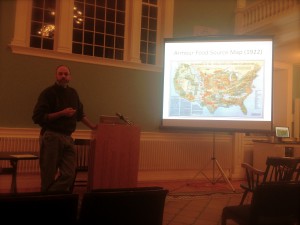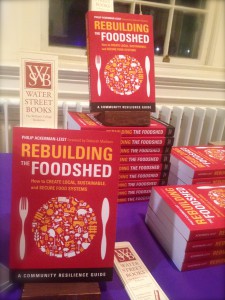by Celeste Berg ’13
Philip Ackerman-Leist is all about the practical. On the evening of Wednesday, February 13th, the author, farmer, and professor delivered a talk on his recent book Rebuilding the Foodshed: How to Create Local, Sustainable, and Secure Food Systems. Roughly 25 attendees, an even mix of students and community members, gathered in brightly lit Griffin Hall, eager to learn about practical application of the “local” buzzword—how can we build regional food systems that are affordable, sustainable, and resilient?
Ackerman-Leist established Green Mountain College’s farm and sustainable agriculture program, born from his vision of integrating hands-on food production and education into the curriculum. He serves

as a professor of the college and the director of the Green Mountain Farm & Food Project. His recent book bears the sub-title “Community Resilience Guide,” and it is this principle that Ackerman-Leist promotes in the text. He encourages readers and listeners to engage deeply in “systems thinking” and critically examine how we can apply the word “local” at a regional level.
Producing a single carrot from his jean pocket, Ackerman-Leist began his talk by describing the characteristics of the weathered orange vegetable. The carrot was well worn from days of travel, yet Ackerman-Leist looked beyond the physical: he was concerned with the production, processing, and distribution processes that delivered this single vegetable to his hand. Following this introduction, Ackerman-Leist delved into the evolution of his thinking about the word “local.”
“Does anyone know where the word foodshed came from?” he questioned the audience. “From watershed,” a voice replied, half-joking because the direct connection appeared obvious, yet the deeper meaning required further explanation. Indeed, this assumption proved correct. US EPA designates a watershed as an “area of land where all of the water that is under it or drains off of it goes into the same place,” a definition that characterizes an area based on what resources are available locally. Ackerman-Leist consequently pointed out that stakeholders have traditionally been concerned with protecting the watershed of their region, but are becoming increasingly invested in conserving the foodshed via the celebration and procurement of local bounty.
“Foodshed is new democracy, not just new economy,” Ackerman-Leist pointed out. Defining nourishment as a community empowerment tool is not a novel concept, but an important one—Ackerman-Leist took this pillar of the food movement one step further by suggesting that healthy food should be conceived as an inalienable human right, on par with water and shelter. Obtaining healthy food for all people is a community-based goal; Ackerman-Leist decried the individualism inherent in the idea of “voting with your fork.”
After some historical background on agricultural production, processing, and distribution in the United States, Ackerman-Leist addressed the flaws in our current food system. A telling chart first displayed the obstacles that minority farm owners face: they receive lower government subsidies, farm less acreage, and obtain less sales revenue than their native counterparts. Next, a pie chart described the “Total Energy Directly and Indirectly Consumed on U.S. Farms, 2002[1]. The chart showed a total of 1.7 quadrillion BTUs used, with 29% of that allocated toward fertilizers. Noting the magnitude of this energy sink, Ackerman-Leist refuted the

tendency to view the food movement through a bifocal lens—we cannot have local trump organic, as both of these features are integral to protecting our foodsheds and our planet. Food processing conditions are also a cause for serious concern. A North Carolina native, Ackerman-Leist illustrated this flaw with a close-to-home example: in Hamlet, NC on September 3rd, 1991, locked doors and a fire at a poultry processing plant led to the deaths of many workers trapped inside. A look at the fuel efficiency of food distribution exemplified the necessity of a wide-angled approach to fixing our food system. In terms of fuel efficiency, boats, trains, and semis are the most efficient distribution vehicles. Farmers’ pickups are the least efficient.
Ackerman-Leist’s solutions embody the importance of practical aggregation, processing, and distribution models. For example, community markets shared and managed by community members represent a model that does not return a substantial profit on sales, but allows connections between producer and consumer. Similarly, “food hub” distributors buy from a large crop of small farmers within a regional food system and sell to consumers; this model “scales up” sustainably. Ackerman-Leist stressed the importance of both aggregation and improved processing techniques: in terms of U.S. food energy consumption, household refrigeration and preparation is by far the largest energy user, and 40% of food is wasted, some of this figure representing food that does not even reach the consumer. Disturbingly, 97% of this wasted food does not get “put back” so that it can be utilized as compost—anaerobic digestion of excreta and other organics is an important component of the food system, and one that could be well suited to local municipalities. Institutional purchasing of local foods is also a “wonderfully complicated” aggregation and distribution model, one that has myriad potential benefits for both the farmer and the institution. Dining at Williams College provides an appropriate context for envisioning the institutional impact on our local foodshed.
An inquiry about how to keep up the food movement’s momentum yielded the response, “Build like hell. As fast as we can while it’s hot,” from Ackerman-Leist. He emphasized that our culture’s impatience makes vigilance and unrelenting perseverance important in the pursuit of practical, sustainable, and resilient foodsheds.
[1] This figure is old but similar to the current one, Ackerman-Leist explained.